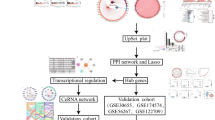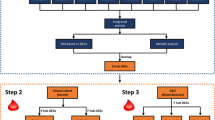Abstract
Multiple sclerosis (MS) is the most prevalent demyelinating disease and the principal cause of neurological disability in young adults. Recent microarray gene expression profiling studies have identified several genetic variants contributing to the complex pathogenesis of MS, however, expressional and functional studies are still required to further understand its molecular mechanism. The present study aimed to analyze the molecular mechanism of MS using microarray analysis combined with bioinformatics techniques. We downloaded the gene expression profile of MS from Gene Expression Omnibus (GEO) and analysed the microarray data using the differentially coexpressed genes (DCGs) and links package in R and Database for Annotation, Visualization and Integrated Discovery. The regulatory impact factor (RIF) algorithm was used to measure the impact factor of transcription factor. A total of 1,297 DCGs between MS patients and healthy controls were identified. Functional annotation indicated that these DCGs were associated with immune and neurological functions. Furthermore, the RIF result suggested that IKZF1, BACH1, CEBPB, EGR1, FOS may play central regulatory roles in controlling gene expression in the pathogenesis of MS. Our findings confirm the presence of multiple molecular alterations in MS and indicate the possibility for identifying prognostic factors associated with MS pathogenesis.


Similar content being viewed by others
References
Compston A, Coles A (2008) Multiple sclerosis. Lancet 372(9648):1502–1517. doi:10.1016/S0140-6736(08)61620-7
Rosati G (2001) The prevalence of multiple sclerosis in the world: an update. Neurol Sci 22(2):117–139
Fontoura P, Garren H (2010) Multiple sclerosis therapies: molecular mechanisms and future. Results Probl Cell Differ 51:259–285. doi:10.1007/400_2010_36
Smolders J (2011) Vitamin D and multiple sclerosis: correlation, causality, and controversy. Autoimmune Dis 2011:629538. doi:10.4061/2011/629538
van der Mei IA, Ponsonby AL, Dwyer T, Blizzard L, Simmons R, Taylor BV, Butzkueven H, Kilpatrick T (2003) Past exposure to sun, skin phenotype, and risk of multiple sclerosis: case–control study. BMJ 327(7410):316. doi:10.1136/bmj.327.7410.316327/7410/316
Hafler DA, Compston A, Sawcer S, Lander ES, Daly MJ, De Jager PL, de Bakker PI, Gabriel SB, Mirel DB, Ivinson AJ, Pericak-Vance MA, Gregory SG, Rioux JD, McCauley JL, Haines JL, Barcellos LF, Cree B, Oksenberg JR, Hauser SL (2007) Risk alleles for multiple sclerosis identified by a genomewide study. N Engl J Med 357(9):851–862. doi:10.1056/NEJMoa073493
Schonrock LM, Gawlowski G, Bruck W (2000) Interleukin-6 expression in human multiple sclerosis lesions. Neurosci Lett 294(1):45–48
Lock C, Hermans G, Pedotti R, Brendolan A, Schadt E, Garren H, Langer-Gould A, Strober S, Cannella B, Allard J, Klonowski P, Austin A, Lad N, Kaminski N, Galli SJ, Oksenberg JR, Raine CS, Heller R, Steinman L (2002) Gene-microarray analysis of multiple sclerosis lesions yields new targets validated in autoimmune encephalomyelitis. Nat Med 8(5):500–508. doi:10.1038/nm0502-500nm0502-500
Chabas D, Baranzini SE, Mitchell D, Bernard CC, Rittling SR, Denhardt DT, Sobel RA, Lock C, Karpuj M, Pedotti R, Heller R, Oksenberg JR, Steinman L (2001) The influence of the proinflammatory cytokine, osteopontin, on autoimmune demyelinating disease. Science 294(5547):1731–1735. doi:10.1126/science.1062960294/5547/1731
John GR, Shankar SL, Shafit-Zagardo B, Massimi A, Lee SC, Raine CS, Brosnan CF (2002) Multiple sclerosis: re-expression of a developmental pathway that restricts oligodendrocyte maturation. Nat Med 8(10):1115–1121. doi:10.1038/nm781nm781
Lim CK, Brew BJ, Sundaram G, Guillemin GJ (2010) Understanding the roles of the kynurenine pathway in multiple sclerosis progression. Int J Tryptophan Res 3:157–167
Kanehisa M (2002) The KEGG database. Novartis Found Symp 247:91–101 (discussion 101–103, 119–128, 244–152)
Kanehisa M, Goto S (2000) KEGG: Kyoto encyclopedia of genes and genomes. Nucleic Acids Res 28(1):27–30
Carter SL, Brechbuhler CM, Griffin M, Bond AT (2004) Gene co-expression network topology provides a framework for molecular characterization of cellular state. Bioinformatics 20(14):2242–2250. doi:10.1093/bioinformatics/bth234bth234
Choi JK, Yu U, Yoo OJ, Kim S (2005) Differential coexpression analysis using microarray data and its application to human cancer. Bioinformatics 21(24):4348–4355. doi:10.1093/bioinformatics/bti722
de la Fuente A (2010) From ‘differential expression’ to ‘differential networking’—identification of dysfunctional regulatory networks in diseases. Trends Genet 26(7):326–333. doi:10.1016/j.tig.2010.05.001
Yu H, Liu BH, Ye ZQ, Li C, Li YX, Li YY (2011) Link-based quantitative methods to identify differentially coexpressed genes and gene pairs. BMC Bioinform 12:315. doi:10.1186/1471-2105-12-315
Liu BH, Yu H, Tu K, Li C, Li YX, Li YY (2010) DCGL: an R package for identifying differentially coexpressed genes and links from gene expression microarray data. Bioinformatics 26(20):2637–2638. doi:10.1093/bioinformatics/btq471
Team RDC (2011) R: a language and environment for statistical computing. R Foundation for Statistical Computing, Vienna
Benjamini YHY (1995) Controlling the false discovery rate: a practical and powerful approach to multiple testing. J R Stat Soc Ser B Methodol 57:289–300
da Huang W, Sherman BT, Lempicki RA (2009) Systematic and integrative analysis of large gene lists using DAVID bioinformatics resources. Nat Protoc 4(1):44–57. doi:10.1038/nprot.2008.211
Reverter A, Hudson NJ, Nagaraj SH, Perez-Enciso M, Dalrymple BP (2010) Regulatory impact factors: unraveling the transcriptional regulation of complex traits from expression data. Bioinformatics 26(7):896–904. doi:10.1093/bioinformatics/btq051
Shannon P, Markiel A, Ozier O, Baliga NS, Wang JT, Ramage D, Amin N, Schwikowski B, Ideker T (2003) Cytoscape: a software environment for integrated models of biomolecular interaction networks. Genome Res 13(11):2498–2504. doi:10.1101/gr.123930313/11/2498
Hauser SL, Oksenberg JR (2006) The neurobiology of multiple sclerosis: genes, inflammation, and neurodegeneration. Neuron 52(1):61–76. doi:10.1016/j.neuron.2006.09.011
Baranzini SE, Galwey NW, Wang J, Khankhanian P, Lindberg R, Pelletier D, Wu W, Uitdehaag BM, Kappos L, Polman CH, Matthews PM, Hauser SL, Gibson RA, Oksenberg JR, Barnes MR (2009) Pathway and network-based analysis of genome-wide association studies in multiple sclerosis. Hum Mol Genet 18(11):2078–2090. doi:10.1093/hmg/ddp120
Cunninghame Graham DS, Morris DL, Bhangale TR, Criswell LA, Syvanen AC, Ronnblom L, Behrens TW, Graham RR, Vyse TJ (2011) Association of NCF2, IKZF1, IRF8, IFIH1, and TYK2 with systemic lupus erythematosus. PLoS Genet 7(10):e1002341. doi:10.1371/journal.pgen.1002341
Kastner P, Chan S (2011) Role of Ikaros in T-cell acute lymphoblastic leukemia. World J Biol Chem 2(6):108–114. doi:10.4331/wjbc.v2.i6.108
Payne KJ, Dovat S (2011) Ikaros and tumor suppression in acute lymphoblastic leukemia. Crit Rev Oncog 16(1–2):3–12
Vassalli P (1992) The pathophysiology of tumor necrosis factors. Annu Rev Immunol 10:411–452. doi:10.1146/annurev.iy.10.040192.002211
Tyor WR, Glass JD, Baumrind N, McArthur JC, Griffin JW, Becker PS, Griffin DE (1993) Cytokine expression of macrophages in HIV-1-associated vacuolar myelopathy. Neurology 43(5):1002–1009
Raine CS (1995) Multiple sclerosis: TNF revisited, with promise. Nat Med 1(3):211–214
Tan J, Town T, Paris D, Placzek A, Parker T, Crawford F, Yu H, Humphrey J, Mullan M (1999) Activation of microglial cells by the CD40 pathway: relevance to multiple sclerosis. J Neuroimmunol 97(1–2):77–85
Tan J, Town T, Saxe M, Paris D, Wu Y, Mullan M (1999) Ligation of microglial CD40 results in p44/42 mitogen-activated protein kinase-dependent TNF-alpha production that is opposed by TGF-beta 1 and IL-10. J Immunol 163(12):6614–6621
Jana M, Dasgupta S, Liu X, Pahan K (2002) Regulation of tumor necrosis factor-alpha expression by CD40 ligation in BV-2 microglial cells. J Neurochem 80(1):197–206
Mycko MP, Papoian R, Boschert U, Raine CS, Selmaj KW (2004) Microarray gene expression profiling of chronic active and inactive lesions in multiple sclerosis. Clin Neurol Neurosurg 106(3):223–229. doi:10.1016/j.clineuro.2004.02.019
Antony JM, Ellestad KK, Hammond R, Imaizumi K, Mallet F, Warren KG, Power C (2007) The human endogenous retrovirus envelope glycoprotein, syncytin-1, regulates neuroinflammation and its receptor expression in multiple sclerosis: a role for endoplasmic reticulum chaperones in astrocytes. J Immunol 179(2):1210–1224
Yu JS, Hayashi T, Seboun E, Sklar RM, Doolittle TH, Hauser SL (1991) Fos RNA accumulation in multiple sclerosis white matter tissue. J Neurol Sci 103(2):209–215
Acknowledgments
This study was supported by National Natural Science Foundation of China, Yangtai Guan (81230027), National Natural Science Foundation of China, Mingyuan Liu (81200924) and Natural Science Foundation of Shanghai Province, China, Mingyuan Liu (12ZR1427400).
Author information
Authors and Affiliations
Corresponding author
Additional information
Mingyuan Liu and Xiaojun Hou should regard as the co-first authors.
Rights and permissions
About this article
Cite this article
Liu, M., Hou, X., Zhang, P. et al. Microarray gene expression profiling analysis combined with bioinformatics in multiple sclerosis. Mol Biol Rep 40, 3731–3737 (2013). https://doi.org/10.1007/s11033-012-2449-3
Received:
Accepted:
Published:
Issue Date:
DOI: https://doi.org/10.1007/s11033-012-2449-3




